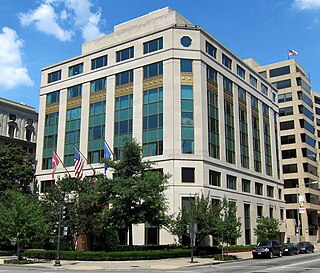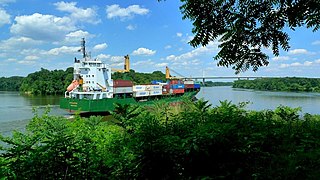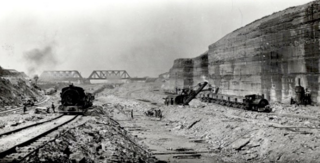Related Research Articles
Social history, often called "history from below", is a field of history that looks at the lived experience of the past. Historians who write social history are called social historians. Social history came to prominence in the 1960s, with some arguing that its origins lie over a century earlier.

Lewis Wickes Hine was an American sociologist and muckraker photographer. His photographs were instrumental in bringing about the passage of the first child labor laws in the United States.

Indentured servitude is a form of labor in which a person is contracted to work without salary for a specific number of years. The contract, called an "indenture", may be entered voluntarily for purported eventual compensation or debt repayment, or imposed involuntarily as a judicial punishment. The practice has been compared to the similar institution of slavery, although there are differences.

Navvy, a clipping of navigator (UK) or navigational engineer (US), is particularly applied to describe the manual labourers working on major civil engineering projects and occasionally to refer to mechanical shovels and earth moving machinery. The term was coined in the late 18th century in Great Britain when numerous canals were being built, which were also sometimes known as "navigations".

A dockworker is a waterfront manual laborer who is involved in loading and unloading ships.

Corvée is a form of unpaid forced labour that is intermittent in nature, lasting for limited periods of time, typically only a certain number of days' work each year. Statute labour is a corvée imposed by a state for the purposes of public works. As such it represents a form of levy (taxation). Unlike other forms of levy, such as a tithe, a corvée does not require the population to have land, crops or cash.
Labor history is a sub-discipline of social history which specializes on the history of the working classes and the labor movement. Labor historians may concern themselves with issues of gender, race, ethnicity, and other factors besides class but chiefly focus on urban or industrial societies which distinguishes it from rural history.

The term "home front" covers the activities of the civilians in a nation at war. World War II was a total war; homeland military production became vital to both the Allied and Axis powers. Life on the home front during World War II was a significant part of the war effort for all participants and had a major impact on the outcome of the war. Governments became involved with new issues such as rationing, manpower allocation, home defense, evacuation in the face of air raids, and response to occupation by an enemy power. The morale and psychology of the people responded to leadership and propaganda. Typically women were mobilized to an unprecedented degree.

The Laborers' International Union of North America, often shortened to just the Laborers' Union, is an American and Canadian labor union formed in 1903. As of 2017, they had about 500,000 members, about 80,000 of whom are in Canada. The current general president is Brent Booker who was appointed general president in 2023. There are nine regions across North America; these regions are further divided into 500 local unions. One region is in Toronto, Canada, and is led by Joseph Mancinelli, Local 183, which is the largest construction local union in North America.

Dutch Gap Canal is located on the James River in Chesterfield County, Virginia just north of the lost 17th-century town of Henricus. The canal's construction was initiated by Union forces during the American Civil War to bypass a meander loop of the river around a peninsula known as Farrar's Island that was controlled by Confederate artillery. The canal was completed after the war and is now the main channel of the James River in this area. Today, the area south of the canal is the location of the Dutch Gap Conservation Area and Henricus Historical Park.

Hinduism is practised throughout South Africa, but primarily in KwaZulu-Natal. Approximately 1.1% of the South African population professed to be Hindu, according to the 2011 census. This is down from the 1.4% based on the 1996 census. The 2016 General Household Survey measured a further decline to 0.9%.

After the Indian Rebellion of 1857, the British Government took over the administration to establish the British Raj. The British Raj was the period of British Parliament rule on the Indian subcontinent between 1858 and 1947, for around 89 years of British occupation. The system of governance was instituted in 1858 when the rule of the East India Company was transferred to the Crown in the person of Queen Victoria.
The Philip Taft Labor History Book Award is sponsored by the Cornell University School of Industrial and Labor Relations in cooperation with the Labor and Working-Class History Association for books relating to labor history of the United States. Labor history is considered "in a broad sense to include the history of workers, their institutions, and their workplaces, as well as the broader historical trends that have shaped working-class life, including but not limited to: immigration, slavery, community, the state, race, gender, and ethnicity." The award is named after the noted labor historian Philip Taft (1902–1976).
This is a bibliography of selected publications on the history of Australia.

The working class is a subset of employees who are compensated with wage or salary-based contracts, whose exact membership varies from definition to definition. Members of the working class rely primarily upon earnings from wage labour. Most common definitions of "working class" in use in the United States limit its membership to workers who hold blue-collar and pink-collar jobs, whose income is insufficiently high to place them in the middle class, or both. However, socialists define "working class" to include all workers who fall into this category; thus, this definition can include almost all of the working population of industrialized economies.

The economic history of World War I covers the methods used by the First World War (1914–1918), as well as related postwar issues such as war debts and reparations. It also covers the economic mobilization of labour, industry, and agriculture leading to economic failure. It deals with economic warfare such as the blockade of Germany, and with some issues closely related to the economy, such as military issues of transportation. For a broader perspective see home front during World War I.

Indentured servitude in British America was the prominent system of labor in the British American colonies until it was eventually supplanted by slavery. During its time, the system was so prominent that more than half of all immigrants to British colonies south of New England were white servants, and that nearly half of total white immigration to the Thirteen Colonies came under indenture. By the beginning of the American Revolutionary War in 1775, only 2 to 3 percent of the colonial labor force was composed of indentured servants.

Irish indentured servants were Irish people who became indentured servants in territories under the control of the British Empire, such as the British West Indies, British North America and later Australia.

When Britain emerged victorious from the Second World War, the Labour Party under Clement Attlee came to power and created a comprehensive welfare state, with the establishment of the National Health Service giving free healthcare to all British citizens, and other reforms to benefits. The Bank of England, railways, heavy industry, and coal mining were all nationalised. The most controversial issue was nationalisation of steel, which was profitable, unlike the others. Economic recovery was slow, housing was in short supply, and bread was rationed along with many necessities in short supply. It was an "age of austerity". American loans and Marshall Plan grants kept the economy afloat. India, Pakistan, Burma, and Ceylon gained independence. Britain was a strong anti-Soviet factor in the Cold War and helped found NATO in 1949. Many historians describe this era as the "post-war consensus", emphasising how both the Labour and Conservative Parties until the 1970s tolerated or encouraged nationalisation, strong trade unions, heavy regulation, high taxes, and a generous welfare state.

The Welland Canal Riot occurred in Ontario, Canada. Armed conflict among Irish workers made the Second Welland Canal construction a riot area from 1842 to 1844. The laborers were continuously attacking and counterattacking. The police force became involved to protect and arrest.
References
- ↑ "BGSU:Peter Way to explore gender's role". www.bgsu.edu. Archived from the original on 2006-09-12.
- ↑ "Peter Way | History". www.uwindsor.ca. Archived from the original on 2009-11-01.
- ↑ "Prize Winning Articles". WMQ. OIEAHC . Retrieved November 17, 2014.
- ↑ "Department of History".